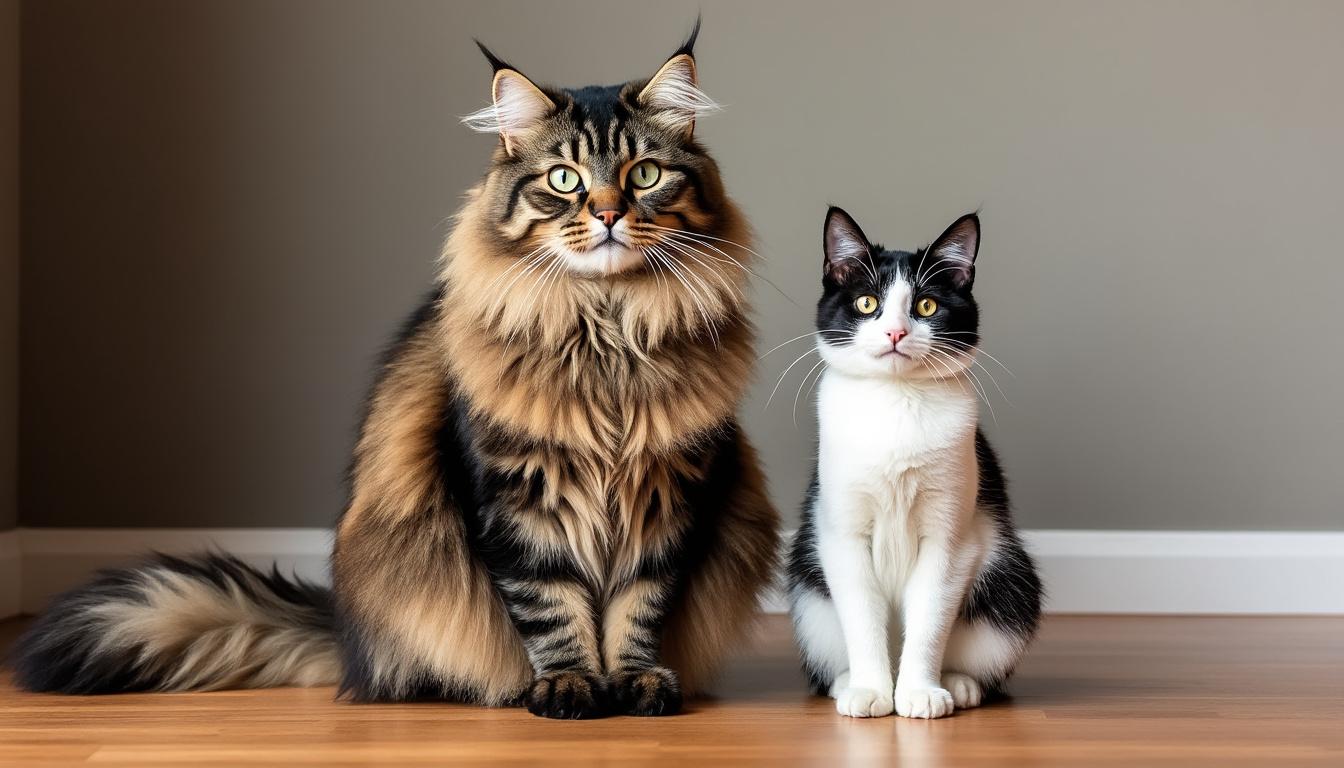Maine Coons are renowned for their exceptional size and impressive presence, often taking cat ownership to a whole new dimension. These magnificent felines, often referred to as the “gentle giants” of the cat world, capture attention not only with their size but also with their playful, affectionate nature. As the popularity of Maine Coons continues to rise, many potential owners curious about how large these cats can grow are eager for insights and information. Tracking their growth from kittens to full-sized cats reveals fascinating details about their development, distinctive traits, and health considerations, ensuring that those who bring home a Maine Coon understand and appreciate their impressive size.
Brief
- 🐱 Maine Coons are touted as “gentle giants” due to their size and friendly nature.
- 📏 Adult males can weigh between 15 to 25 pounds on average, while females often range from 10 to 15 pounds.
- 📈 Maine Coons grow gradually, reaching full maturity at around 3 to 5 years of age.
- ✨ Their size is influenced by genetics, adaptation to cold climates, and selective breeding practices.
- 💖 Despite their large stature, they are affectionate and social, often displaying dog-like loyalty.
From Kitten to Colossus: The Growth Journey of a Maine Coon
When you first adopt a Maine Coon kitten, you might be surprised to find that they already start off a bit bigger than your average house cat. However, the real story of their growth is more of a gradual evolution than a quick leap into size. Unlike many domestic cats that reach their full size by their first birthday, Maine Coons take their time—growing slowly and surely until they hit maturity around 3 to 5 years of age. This extended growth pattern often catches first-time Maine Coon owners off guard as they observe their kittens become substantially larger year after year.
At approximately three months, Maine Coon kittens typically weigh between 3 to 5 pounds (1.36 to 2.27 kg), already rivaling many adult cats from smaller breeds. As time goes on, these kittens develop robust bone structures, strong muscles, and their signature luxurious coats that make them truly distinctive. With every passing month, they seem to grow taller and bulkier, leaving many owners marveling at their steady transformation.

A Comprehensive Growth Timeline
Understanding a Maine Coon’s growth allows pet parents to manage their nutritional needs better and ensure they grow healthy and strong. Here’s a simple growth timeline for Maine Coons:
| Age | Weight Range | Growth Characteristics |
|---|---|---|
| 3 Months | 3-5 lbs (1.36-2.27 kg) | Kitten fluff and developing bulk |
| 6 Months | 6-10 lbs (2.72-4.54 kg) | Major growth spurts, more muscle |
| 12 Months | 8-15 lbs (3.63-6.8 kg) | Transitioning into young adults |
| 2 Years | 10-20 lbs (4.5-9.07 kg) | Filling out, gaining weight and muscle |
| 3-5 Years | 15-25 lbs (6.8-11.3 kg) | Full maturity, final size reached |
During the initial growth phases, feeding the right diet becomes crucial. Many owners opt for high-quality grain-free cat food brands like Purina, Royal Canin, or Hill’s Science Diet to ensure their Maine Coons receive proper nutrition tailored to their growth stages. It’s essential to remember that while their personalities are shaping during these growth years, maintaining their health is of utmost importance.
Average Size of a Full-Grown Maine Coon
Once a Maine Coon reaches adulthood, they present an impressive size that reflects their unique genetic makeup and environmental adaptations. On average, adult male Maine Coons weigh between 15 to 25 pounds (6.8 to 11.3 kg), while females are typically smaller, clocking in at around 10 to 15 pounds (4.5 to 6.8 kg). While most follow this weight range, some exceptional specimens can tip the scales at over 30 pounds, though this is uncommon and might indicate health issues like obesity, which can complicate matters down the line.

Physical Dimensions Overview
The dimensions of a Maine Coon not only represent their weight but also their robust build, tufted ears, and fluffy tails. Here’s a breakdown of the average physical traits:
| Trait | Male | Female |
|---|---|---|
| Weight | 15-25 lbs (6.8-11.3 kg) | 10-15 lbs (4.5-6.8 kg) |
| Height (shoulder to ground) | 10-16 inches | 8-14 inches |
| Length (nose to tail) | 19-40 inches | 19-40 inches |
| Tail Length | 12-18 inches | 12-18 inches |
These physical traits combine to create a cat that not only looks majestic but feels that way too. Their structural integrity is complemented by a thick double coat designed to withstand harsh winter climates, making them appear even larger and fluffier.
Male vs. Female Maine Coon: What to Expect
While both male and female Maine Coons share the breed’s trademark features, there are notable differences in their size and appearance. Generally speaking, male Maine Coons are larger and bulkier, exhibiting broader heads and more muscular builds. They often sport prominent ruffs around their necks, which can provide a lion-like silhouette that delights cat enthusiasts and casual observers alike.
Females, on the other hand, tend to display a more refined elegance with slight frames. Nevertheless, they still exude the stunning traits that define the breed. Interestingly, while males may have a goofy demeanor and be a bit more attention-seeking, females are often incredibly playful and affectionate as well.
Comparative Analysis: Maine Coons vs. Other Breeds
So how do Maine Coons stack up against other breeds known for their size and fur? Here’s a quick comparison featuring some popular breeds:
| Breed | Average Weight | Height | Length |
|---|---|---|---|
| Maine Coon | 10–25 lbs (4.5–11.3 kg) | 10–16 inches | 19–40 inches |
| Average Domestic Cat | 8–11 lbs (3.63–5 kg) | 9–10 inches | ~18 inches |
| Norwegian Forest Cat | 9–20 lbs (4–9 kg) | 9–12 inches | 12–18 inches |
| Turkish Angora | 7–10 lbs (3–4.5 kg) | 8–10 inches | 14–16 inches |
Maine Coons hold the crown as the kings and queens of house cats in every dimension, making them both impressive companions and eye-catching pets.
What Makes Them So Big?
The fabulous size of the Maine Coon is a result of a combination of factors, including selective breeding and natural evolutionary adaptations. Originally hailing from the cold climates of northeastern United States, where winters can be harsh, these cats developed physical traits that contributed to their size and resilience:
- ❄️Dense Fur: Their thick, water-resistant fur provides insulation against biting cold.
- 🐾Large Paws: Resembling snowshoes, their wide paws allow for easier movement through snow.
- 🌬️Bushy Tails: These tails serve a dual purpose: providing warmth and balance.
As breeders recognized the Maine Coon’s uniquely beneficial attributes, they began emphasizing size and strength in their breeding programs, resulting in the commanding cats we see today. This distinct blend of genetic selection and responsiveness to their environments shaped the Maine Coon’s overall appearance, allowing them to thrive as domesticated companions.
Notable Maine Coon Size Records
When discussing Maine Coons and their size, some remarkable individual cats deserve mention. For instance, Stewie holds the record for being the longest Maine Coon, measuring an astonishing 48.5 inches from nose to tail. Another notable cat, Ludo, was reputed to weigh 34 pounds (15.4 kg) during its prime. These examples illustrate what extraordinary size these cats can potentially achieve under ideal conditions.
Growth Timeline: When Do Maine Coons Reach Full Size?
Unlike the majority of domestic cats that reach their full size by about one year of age, Maine Coons take their time, stretching their growth over a span of several years. Here’s a general breakdown of their growth phasing:
- 🍼3-7 Months: Major kitten growth spurts where rapid increases in weight and muscle take place.
- 💪12-18 Months: They start to fill out their muscle mass, looking a bit more adult-like.
- 👩🎓3-5 Years: At this stage, they reach their full adult size and maturity.
It’s worth noting that spaying or neutering your Maine Coon before they reach full growth can impact their final size due to hormonal changes. If you want to gauge how large your Maine Coon may become, examining the parents might give you a good baseline for reference.
Health Considerations Related to Size
With great size comes significant responsibility. Due to their larger frames, Maine Coons can be more susceptible to specific health conditions. Some health considerations include:
- 💖Hypertrophic Cardiomyopathy (HCM): A prevalent genetic heart condition particularly noted in Maine Coons.
- 🦴Hip Dysplasia: Heavier males, in particular, may battle with joint issues as they age.
- 🍔Obesity: Overfeeding or lack of activity can worsen joint and heart health problems.
Regular visits to the vet, proper portion control when feeding, and engaging playtime are vital for maintaining a healthy weight and preventing chronic diseases. These measures help ensure your Maine Coon not only grows into their full size but leads a healthy, vibrant life.
Personality in a Large Package
Despite their impressive physiques, Maine Coons are remarkably affectionate and social creatures. They’re often likened to dogs in their loyalty, enjoying following their human companions and actively participating in family activities. It’s not unusual for them to indulge in playful antics, including a round of fetch or climbing to high perches like true adventurers.
Their compelling personalities help to endear them to families and individuals alike. Owning one may bring unexpected joy and companionship into your household, as these delightful cats have a way of filling the home with love and laughter.
FAQs About Maine Coon Size & Care
How big can a Maine Coon get?
Adult male Maine Coons can weigh 15 to 25 pounds and measure up to 40 inches in length. Some exceptional cats have reached 30+ pounds.
When do Maine Coons stop growing?
Most Maine Coons reach their full size between 3 to 5 years of age.
Is my Maine Coon overweight?
If your Maine Coon exceeds 25 pounds, it may be overweight unless confirmed by a vet to be naturally large. Regular weight checks are essential.
Why is my Maine Coon so small?
Genetics, early neutering, or poor diet can all influence adult size. Consult your vet to rule out health issues.
Are male Maine Coons always bigger?
Typically, yes. Males are often 2-5 pounds heavier than females, with bulkier frames and broader heads.

